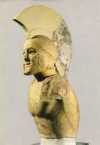 Accidentally discovered in 1934 while scientists were experimenting with sonar, sonoluminescence is the emission of short bursts of light from the implosion of bubbles formed in a liquid medium as sound waves pass through it. Scientists have since theorized that the temperatures inside the bubbles are hot enough to melt steel. In 2001, the first known instance of an animal producing light by sonoluminescence was reported. What creature exhibited such behavior? Discuss
Accidentally discovered in 1934 while scientists were experimenting with sonar, sonoluminescence is the emission of short bursts of light from the implosion of bubbles formed in a liquid medium as sound waves pass through it. Scientists have since theorized that the temperatures inside the bubbles are hot enough to melt steel. In 2001, the first known instance of an animal producing light by sonoluminescence was reported. What creature exhibited such behavior? Discuss
Source: The Free Dictionary
 The Derveni Papyrus, Europe’s oldest surviving manuscript, is an ancient Greek papyrus scroll dating to approximately 340 BCE. Found in Derveni, in northern Greece, in 1962, the scroll is an allegorical commentary on a poem ascribed to the mythic poet Orpheus which discusses the birth of the gods. It begins with the words “Close the doors, you uninitiated,” a famous admonition to secrecy. The text was officially published how many years after its discovery in 1962?
The Derveni Papyrus, Europe’s oldest surviving manuscript, is an ancient Greek papyrus scroll dating to approximately 340 BCE. Found in Derveni, in northern Greece, in 1962, the scroll is an allegorical commentary on a poem ascribed to the mythic poet Orpheus which discusses the birth of the gods. It begins with the words “Close the doors, you uninitiated,” a famous admonition to secrecy. The text was officially published how many years after its discovery in 1962?  In the Spartan tradition of Krypteia, young men who successfully completed their rigorous training regime were sent into the countryside unarmed and told to kill any members of Sparta’s serf population, or “Helots,” that they encountered at night and to take any food they needed. The tradition derives it name from a Greek word meaning “hidden, secret things,” and its goal and nature are still a matter of debate among historians. What purposes do scholars believe Krypteia served?
In the Spartan tradition of Krypteia, young men who successfully completed their rigorous training regime were sent into the countryside unarmed and told to kill any members of Sparta’s serf population, or “Helots,” that they encountered at night and to take any food they needed. The tradition derives it name from a Greek word meaning “hidden, secret things,” and its goal and nature are still a matter of debate among historians. What purposes do scholars believe Krypteia served?  Struthiomimus was a long-legged, possibly feathered, ostrich-like dinosaur that lived in the area that is now Alberta, Canada, during the late Cretaceous Period, approximately 75 million years ago. With a slender neck and a toothless beak, it is believed that the bipedal dinosaur’s only defenses against predators were its powerful legs, which gave Struthiomimus the ability to run rapidly, much like an ostrich. How fast was it?
Struthiomimus was a long-legged, possibly feathered, ostrich-like dinosaur that lived in the area that is now Alberta, Canada, during the late Cretaceous Period, approximately 75 million years ago. With a slender neck and a toothless beak, it is believed that the bipedal dinosaur’s only defenses against predators were its powerful legs, which gave Struthiomimus the ability to run rapidly, much like an ostrich. How fast was it?  Misanthropy is a general dislike or distrust of the human species. Typically motivated by social alienation or feelings of contempt for society’s prevailing characteristics, misanthropes express a dislike for humanity as a whole, but can have normal relationships with some individuals. Overt expressions of misanthropy can be attributed to characters throughout literature. What existentialist philosopher and writer famously wrote that “hell is other people” in his play No Exit?
Misanthropy is a general dislike or distrust of the human species. Typically motivated by social alienation or feelings of contempt for society’s prevailing characteristics, misanthropes express a dislike for humanity as a whole, but can have normal relationships with some individuals. Overt expressions of misanthropy can be attributed to characters throughout literature. What existentialist philosopher and writer famously wrote that “hell is other people” in his play No Exit?  Extinct since the mid 20th century, the pig-footed bandicoot was a small, mostly herbivorous marsupial of the plains of inland Australia. About the size of a kitten, the pig-footed bandicoot had large, pointed ears, a long tail, long, slender limbs, and, as its name suggests, hoof-like nails on its forefeet and hind legs, making it unique among marsupials. Though its decline coincided with the arrival of Europeans, the cause of its extinction remains uncertain. What are some theories?
Extinct since the mid 20th century, the pig-footed bandicoot was a small, mostly herbivorous marsupial of the plains of inland Australia. About the size of a kitten, the pig-footed bandicoot had large, pointed ears, a long tail, long, slender limbs, and, as its name suggests, hoof-like nails on its forefeet and hind legs, making it unique among marsupials. Though its decline coincided with the arrival of Europeans, the cause of its extinction remains uncertain. What are some theories?  Now a term used to describe any drunken revelry, bacchanalia were wild festivals honoring the Greco-Roman god of wine, Bacchus. Introduced around 200 BCE, bacchanalia were originally held in secret 3 times a year and attended only by women. Later, admission was opened to men and celebrations became as frequent as 5 times a month. The notoriety of the festivals led to a Senate decree in 186 BCE prohibiting them except in the event of special approval. What happened to those who defied the decree?
Now a term used to describe any drunken revelry, bacchanalia were wild festivals honoring the Greco-Roman god of wine, Bacchus. Introduced around 200 BCE, bacchanalia were originally held in secret 3 times a year and attended only by women. Later, admission was opened to men and celebrations became as frequent as 5 times a month. The notoriety of the festivals led to a Senate decree in 186 BCE prohibiting them except in the event of special approval. What happened to those who defied the decree?  Known in Costa Rica as the “Jesus Christ lizard” for its ability to run short distances across water using both its feet and tail for support, the plumed basilisk is a species of lizard native to Latin America, with a natural habitat that ranges from Mexico to Ecuador. An excellent swimmer, Basiliscus plumifrons can stay under water for up to 30 minutes. Plumed basilisks are omnivorous and eat insects, small mammals and lizards, fruits, and flowers. What predators prey on the lizard?
Known in Costa Rica as the “Jesus Christ lizard” for its ability to run short distances across water using both its feet and tail for support, the plumed basilisk is a species of lizard native to Latin America, with a natural habitat that ranges from Mexico to Ecuador. An excellent swimmer, Basiliscus plumifrons can stay under water for up to 30 minutes. Plumed basilisks are omnivorous and eat insects, small mammals and lizards, fruits, and flowers. What predators prey on the lizard?  Since their discovery on the Indonesian island of Flores in 2003, small, hominid remains—labeled Homo floresiensis—have divided scientists into two camps. While some believe the remains are the bones of a modern human with a disorder that results in a smaller-than-average skull, others see them as evidence of a newly discovered species in the genus Homo that lived among modern humans and survived until as recently as 12,000 years ago. What arguments have been raised by both sides?
Since their discovery on the Indonesian island of Flores in 2003, small, hominid remains—labeled Homo floresiensis—have divided scientists into two camps. While some believe the remains are the bones of a modern human with a disorder that results in a smaller-than-average skull, others see them as evidence of a newly discovered species in the genus Homo that lived among modern humans and survived until as recently as 12,000 years ago. What arguments have been raised by both sides?